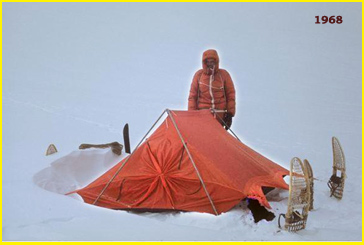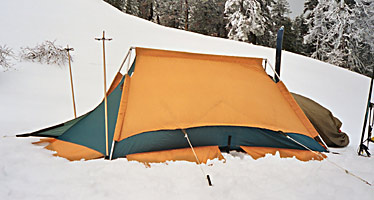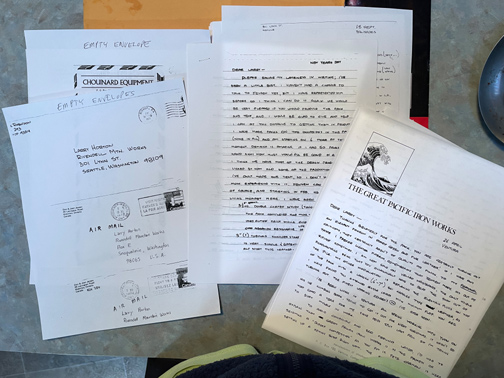

Wyoming 1981: it's the end of a mountain dream, a sad day indeed. Don Wittenberger has arrived in Victor, Idaho. He has assumed legal ownership of the Rivendell name, trademarks, patterns, tools, and other facets of the company, including the original Rivendell wooden sign. Don Wittenberger recalls, "My Yak Works partner and I drove over to Victor and loaded a lot of stuff in a U-Haul truck, and brought it back to Seattle. The intention was to produce the Rivendell products in The Yak Works plant, and sell them through YW's retail store and catalog, but the partnership broke up before this got off the ground, and when I left YW, I kept Rivendell as part of the settlement with my ex-partner." Nowadays the remanent Rivendell is back in the Seattle area. Don was keeping the Rivendell name alive, but for over 20 years its existence was extremely low-key. Luckily, in 2006, a revival began and has continued into the 2020s. The good news is that a close friend of Don's, Eric Hardee, is producing a limited number of the Rivendell/Jensen packs on a custom-order basis. Click here for more information.
Please Note: All Material on this page, and in all my "History of Gear" webpages, is copyrighted, and no usage of my material is permitted unless explicit permission is granted by me, Bruce B. Johnson, owner of OregonPhotos.com. (email: jupiterman47@gmail.com)
THE
BOMBSHELTER--- in addition to its signature Jensen/Rivendell packs,
the company had a second signature product, and that was the very
unique "Bombshelter" mountaineering tent. Backpacker
no. 6 shows a company ad saying the little tent was being "introduced"
in Summer of 1974...About 350 of these small, "elf-size"
two-man tents were made, the last few utilizing Goretex.  The tent was credited
as a Don Jensen design, but the 1975 catalog also credits climber
Chris Goetze with much of the initial development and testing
of the tent concepts as early as the "early 60s." The
proper sewing of the drum-tight tent and fly required the very
highest sewing skills and experience, and thus their sewing was
entrusted in great part to a specialist named Inez M. ... The
picture to the left dates from 1968, and shows Don Jensen standing
beside an early version of the Bombshelter on a frigid January
day in the High Sierras (picture credit: Ray Willems)..... Click here for more about
Don Jensen and Chris Goetze.
The tent was credited
as a Don Jensen design, but the 1975 catalog also credits climber
Chris Goetze with much of the initial development and testing
of the tent concepts as early as the "early 60s." The
proper sewing of the drum-tight tent and fly required the very
highest sewing skills and experience, and thus their sewing was
entrusted in great part to a specialist named Inez M. ... The
picture to the left dates from 1968, and shows Don Jensen standing
beside an early version of the Bombshelter on a frigid January
day in the High Sierras (picture credit: Ray Willems)..... Click here for more about
Don Jensen and Chris Goetze.

BOMBSHELTER SUPER TENT--- Those who have lived through
a severe windstorm high above timberline in a conventional A-framed
mountain tent, even the best of them by the best manufacturers,
do not wish to relive the experience. Such users take one good
look at the features of the Bombshelter and immediately realize
its genius. Rivendell brashly advertised the Bombshelter as a
tent that could withstand the most violent windstorms a mountain
could throw at the exposed climber. It incorporated a number of innovative features designed to turn
it into a "Super Tent" far stronger than the typical
four-season mountaineering tents of its day, both in terms of
wind-loading and snow-loading.
It incorporated a number of innovative features designed to turn
it into a "Super Tent" far stronger than the typical
four-season mountaineering tents of its day, both in terms of
wind-loading and snow-loading.
Reports that have come to me from folks such as famous gear tester Larry Amkraut, who has tested various tents in extreme places like 6,200 foot Mt. Washington, New Hampshire. Larry wrote, "The only way to value the compact Bombshelter Tent is to take it into winds that knock you off your feet. When all the tents around you have their poles snap and the fabric tear, only then will the value of the Bombshelter be appreciated. ."... He insists that its strength has never been equalled. Development and marketing of both the Bombshelter and the pack were widely discussed with prominent climbers and other players circa 1971-73, such as Doug Robinson and others. I have a small stack of (copies of) some of the original correspondence:

The Rivendell catalog directly refers to extensive testing of Bombshelter prototypes during the 1960s by Chris Goetze, where in side by side tests the weaknesses of failing tents made by other high-profile manufacturers would be dissected and autopsied (Mt. Washington, in the White Mountains, holds the WORLD record for highest surface wind speed, which is 231 mph. See link).... Above is a side view of a Bombshelter without its rainfly.... It was provided to me by Alan Wenker, who is one of this Country's experts in classic gear. Check out my story about surviving a high mountain windstorm below.
Serious climbers who might pitch the tent on tiny ledges halfway up a terrifying face also liked another feature. As one Bombshelter owner notes, "... In a really hairy site, you could run climbing ropes through the cookhole in the floor and sleep in climbing harnesses. In any place so desperate, this is the tent I'd want to have." Image Credit: both pictures of the gold Bombshelter are courtesy of Tim S., the former tent production manager at Rivendell. The pictures were taken in the Tetons near the Rivendell workshop in Victor, Idaho.
Specs on the Bombshelter: Quite lightweight, at slightly less than six pounds. It packed very nicely into one of the upper tubes of a Rivendell Jensen pack.....Gold canopy of 1.9 oz. ripstop nylon, taupe rainfly of 1.1oz ripstop, every possible stress point heavily reinforced by extra stitching, nylon taping, etc. 35 inches high, 46 wide, and 97 inches long. 5 pounds 12 oz., with snow flaps adding another 5 oz, available cookhole another 1 oz.. Ridgepole made of extremely strong, thick aluminum, 7/8 inch diameter in a thick wall tube. End poles of a slightly lesser diameter tubing. The use of a ridgepole was one of the key strength-building elements in the design; one side-effect you will note is that the ridgepole elminates the bothersome front and rear guylines that all other A-frames had to use for strength and stability.
Bombshelters were created one at a time, only when an order had come in, and most were sewn by a single expert named Inez; some were also sewn by another expert named Cindy. A fellow named Tim wrote to me about his role in tent production: "...my semi-official title was "head of tent production", but I also did some of the photography for the, then, upcoming catalog."
Interesting footnote, 2016: Yak Works part-owner Don Wittenberger was so impressed with the Bombshelter that when he personally acquired the rights to the bankrupt Rivendell company, he proceeded to design a new version of the tent that was to be made of Goretex and which would use carbon-fiber poles. That plan fell through, but even now in 2022 Don and a well-known old-line gear tester in California* dream of producing an updated Bombshelter tent, perhaps even using Cuben fiber as the fabric and carbon fiber poles. (*Larry Amkraut)
GEAR ALERT: Rivendell/Jensen packs are available! Directly from Eric Hardee's website (see page bottom).
History of GEAR Links: The Rivendell Bombshelter was a powerfully-reinforced A-frame design, thus it was neither a geodesic design, nor a design like Jack Stephenson's Elliptical Arc design... Note: A gear tester who owns and has personally tested the Bombshelter under extreme wind conditions asserts that only one other tent possibly equals the Bombshelter, and that is the Stephensons Warmlite special Expedition tent, of which there were several incarnations, beginning with their 3-man "Expedition 3R 2D ET" in their 1977 color catalog, and later the "ERV" tent in 2, 3, or 5 man sizes (later catalogs through about 1991).
...Please Note: All Material on this page, and in all my "History of Gear" webpages, is copyrighted, and no usage of my material is permitted unless explicit permission is granted by me, Bruce B. Johnson, owner of OregonPhotos.com
High in the misty Cascade mountains, the dream of Rivendell lived on for many years. Eric Hardee and Don Wittenberger have been "Keepers of the Flame." Eric has had legal use (via Don Wittenberger) of the authentic Rivendell pack blueprints and has been sewing/selling custom Jensen/Rivendell packs via word of mouth advertising for many years.... Eric can sew up a gorgeous original Jensen or Giant Jensen for you--- Contact him! He is a true lover of this pack. His email is ewak3@juno.com. Tell him that you heard about him from Bruce at OregonPhotos.com. ... Eric has a fine Rivendell pack website, see Eric's own Rivendell website.
We weren't very high on Mt. Shasta when failing daylight decreed that "here" was where we would pitch the tents and set up camp. My altimeter read 9,600 feet on that early May evening, a clean, clear sky above gave us high hopes for success on our planned climb of the 14,000 foot peak. We scurried to get our orange 3 man REI "McKinley" tent up and anchored before darkness. Numb fingers began to be a problem, but we were almost done, and so I took a break to check the thermomether set out atop my pack. 14 degrees it said; I was astounded, it had dropped 15 degrees in just 35 or 40 minutes! We were in for a very cold night!
The three of us had a quick meal of hot oatmeal and some tea, and went to bed. With winter-weight down bags and our reputedly expedition-proven "McKinley" tent, we felt secure, even though by now it was 9 degrees outside, with piercing cold matching the piercing stars.
Sleep came quickly, but sometime in the middle of the night we were startled awake by the sounds of a mighty wind that was swirling and tearing at the mountain's hard-frozen sides. Gusts like giant's hands pummeled and shook our tent. The two ends of the tent were repeatedly pushed violently toward one another, and then released with explosive sounds, and a constant undercurrent of wild generalized flapping worried at our nerves. There was nothing, nothing at all any of us could think of to do, and it was difficult to talk or think in the tumult. We just curled up to wait, hoping the windstorm might subside as suddenly as it had come. Somehow, eventually, I fell into a fitful sleep.
Bright light seemed all around me, I was momentarily confused, but then realized morning had come, and the wild cracking and pounding of the tent had ended. I felt relief, but then knew that something was quite wrong when I pushed my head out of my bag and saw only orange, very close up orange, orange nylon draped right over my face. With a start, it was all clear, the tent was DOWN on top of us!
As we struggled free of our bags and then free of the tangled mess of the tent, we knew we were in trouble. The bar-tacked attachment points of the hooped metal frame had ripped out from the canopy at several points, and it was dismally obvious that the tent wasn't going to be field-repairable. Could we go on with our climb, and use the tent as an oversize bivy sack? Maybe, but an unrelenting 20-30 mph wind tore at us from out of the pure blue sky. Our thinking seemed slow and decisions came with difficulty. My thermometer had risen to only 16 degrees at 10am, and at that point all three of us seemed to reach the same conclusion with really no discussion. We stuffed the broken tent into our packs and headed rapidly downhill to our car far below.
Copyright Bruce B. Johnson 2008, All Rights Reserved.
When you go into the wilderness, bad weather and accidents can damage your gear. The consequences can be serious or even life-threatening, depending on which piece it is, how bad the weather is, how far from help you are, etc.. In my story above, we were lucky in at least two ways-- except for the cold and wind, weather conditions were good; secondly, to get back to our car, all we had to do was walk downhill a mile or two.